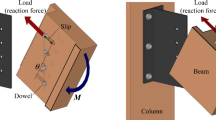Abstract
This paper focuses on analyzing mechanical behavior of dovetail joints with certain geometries and manufacturing imperfections subjected to different loadings. Parameters such as tension stiffness, strength and rotational stiffness are verified using experimental tests. It was found that steeper angle between mortise-tenon contact areas provides significantly higher stiffness of the joint. Another part of the paper focuses on examining influence of manufacturing precision on mechanical performance of dovetail joints. It is found that small gaps up to 2 mm between mortise-tenon contact areas have negligible impact on dovetail performance while gaps of 5 mm may slightly influence joint’s performance by reducing joint’s tensional stiffness by 30 % and strength by 13 %. Furthermore, numerical models of full scale timber frames are constructed and dovetail joints in these models are assigned parameters resulting from experimental testing. Influence of dovetail’s tensional and rotational stiffness on global behavior of timber trusses is examined and it is concluded that rigid hinges carrying no moment can be used for modeling dovetail joints in full scale timber frames. Finally, it is concluded that precise analysis of dovetail’s parameters does not have to be performed when examining global quasistatic behavior of timber structures as these parameters have low impact on structural behavior of the whole construction. Tensional stiffness of dovetail can be used for estimating maximum allowable displacement of tenon for on-site health monitoring of historical dovetail connections.









Similar content being viewed by others
References
Branco JM, Piazza M, Cruz PJS (2011) Experimental evaluation of different strengthening techniques of traditional timber connections. Eng Struct 33:2259–2270
Bulleit WM, Bogue Sandberg L, Drewek Matthew W, O’Bryant Tonia L (1999) behavior and modeling of wood-pegged timber frames. J Struct Eng 125(1):3–9
Chang W-S, Hsu M-F, Komatsu K (2006) Rotational performance of traditional Nuki joints with gap I: theory and verification. J Wood Sci 52(1):58–62
Chang W-S, Hsu M-F (2007) Rotational performance of traditional Nuki joints with gap II: the behavior of butted Nuki joint and its comparison with continuous Nuki joint. J Wood Sci 53(5):401–407
Garbin E, Valluzzi MR, Modena C (2006) Characterization of a dovetail joint for timber roofs. In: Proceedings of WCTE 2006—9th World conference on timber engineering, Portland
Jeong GY, Park M-J, Hwang KH, Park JS (2012) Effects of geometry on mechanical behavior of dovetail connection. In: Proceedings WCTE, Auckland, pp 574–581
Jandejsek I, Nachtrab F, Uhlmann N, Vavřík D (2011) X-ray dynamic defectoscopy utilizing digital image correlation. Nucl Instrum Methods Phys Res A 633(May):185–186
Palma P, Garcia H, Ferreira J, Appleton J, Cruz H (2012) Behaviour and repair of carpentry connections—rotational behaviour of the rafter and tie beam connection in timber roof structures. J Cult Herit 13(3):64–73
Pang SJ, Oh JK, Park CY, Kim SJ, Lee JJ (2012) Effects of size ratios on dovetail joints in Korean traditional wooden building. In: Proceedings WCTE, Auckland
Parisi MA, Cordié C (2010) Mechanical behavior of double-step timber joints. Constr Build Mater 24(8):1364–1371
Tannert T, Lam F, Vallee T (2010) Structural performance of rounded dovetail connections: experimental and numerical investigations. Eur J Wood Wood Prod 69(3):471–482
Xu BH, Bouchair A, Taazount M (2010) 3D non-linear finite element modelling of traditional timber connections. In: Proceedings WCTE 2010, Riva del Garda
Acknowledgments
The authors thank to project NAKI DF12P01OVV004 provided by the Ministry of Culture of the Czech Republic.
Author information
Authors and Affiliations
Corresponding author
Rights and permissions
About this article
Cite this article
Kunecký, J., Arciszewska-Kędzior, A., Sebera, V. et al. Mechanical performance of dovetail joint related to the global stiffness of timber roof structures. Mater Struct 49, 2315–2327 (2016). https://doi.org/10.1617/s11527-015-0651-1
Received:
Accepted:
Published:
Issue Date:
DOI: https://doi.org/10.1617/s11527-015-0651-1




